This is probably as good a point as any to step sideways for a moment and take a look at the growth of Finnish Civil Aviation and the Finnish Aviation Industry through the 1920’s and 1930’s – particularly as there are ramifications for the defence of Finland in some of the decisions that were made from 1931 on. From 1924 on, Finnish Civil Aviation had been developing, with two airlines (Aero Oy – the predecessor to todays Finnair) and Veljekset Karhumäki (run by the Karhumäki Brothers and operating in parallel and in competition with Aero Oy). In addition, a small number of private individuals bought and flew aircraft with some running flying schools and Flying and Gliding clubs were founded in a small number of cities. The 1920’s also saw the foundation of the Suomen Ilmapuolustusliitto or SIPL (Air Defence League), initially a kind of Air Civil Guard. We’ll cover each of these organizations in turn, starting with Aero Oy, then Veljekset Karhumäki followed by the Suomen Ilmapuolustusliitto and finally, defence initiatives of the last half of the 1930’s and how they affected each of these organisations.
Aero Oy
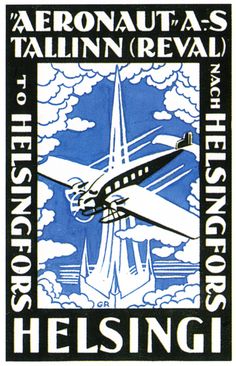
Sign for Estonian Airline Aeronaut
Aero Oy Logo, 1923
Aero Oy, the first real Finnish civil airline, was founded in November 1923 by Consul Bruno Lucander and a small circle of financiers, including Gustav Snellman and Fritiof Ahman. Lieutenant-Colonel Arne Somersalo served initially as the company’s technical adviser. The company’s capital was 500,000 Finnish marks, which was increased on 12 December 1923 by a further one million marks. Lucander had become involved in aviation in 1918 as the general manager of Finland Spedition, a managerial group that ran the Finnish operations of the Estonian airline Aeronaut. At that time, the Finnish aviation industry was dominated by German interests, including the aircraft manufacturer Junkers, a company experienced with aircraft designs that were capable of enduring the extreme physical demands of northern European weather.
Late in 1923, the Estonian airline Aeronaut was acquired by the German company Junkers Flugzeugwerke A.G. and a Junkers F.13 went into service on the Helsinki route. The aircraft was a single-engine monoplane, equipped with a closed cabin and seats for four passengers. The crew consisted of a pilot and a mechanic. Aeronaut had shown that the Junkers F.13 was up to the challenge of operating under the demanding conditions of northern Europe and had made a deep impression on Lucander. He therefore in mid-1923 concluded an agreement with Junkers Flugzeugwerke AG to provide one F.13 aircraft and technical support in exchange for a 50% ownership in the new airline. The charter establishing the company was signed in Helsinki on September 12, 1923, and the company was entered into the trade register on December 11, 1923. Aero took delivery of its first aircraft, a German-registered Junkers F 13 D-335, on 14 March 1924. Three days later, a Junkers factory pilot, Heinrich Putz, flew the aircraft to Helsinki. In the summer of 1924, Aero recruited its first Finnish pilot, Gunnar Lihr, bringing the total number of employees to seven. As the company employed only a few staff, it was not uncommon to see the CEO selling tickets or carrying passengers bags to the aircraft.
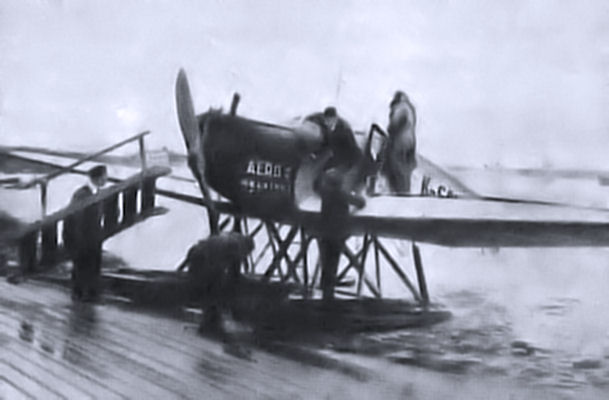
Aero Oy Junkers F13 on the ramp
Aero operated from Katajanokka, Helsinki where in 1923 the facilities consisted of a small terminal building and one seaplane ramp which Aero Oy had built that summer. Its maiden commercial flight was flown on March 20, 1924 from Helsinki to Tallinn, Estonia, with Junkers F.13 aircraft equipped with floats (the F.13 was a single-engined six-seater – two crew and four passengers) – the pilot was Gunnar Lihr and the flight carried 162 kilos of mail. The company’s aircraft were fitted with water floats in the summer and skis in the winter because at that time Helsinki and Tallinn had no airfields.
Also in 1924 the Company purchased a second F.13 and from June 2 1924 began to operate the Helsinki-Stockholm route during the summer months in competition with the newly founded Swedish company A.B. Aerotransport (ABA). With rail connections from Tallin and from Stockholm to Gothenburg, travelers were afforded quick passage to Copenhagen, Konigsberg, and Berlin. Gothenburg also offered flight connections to Copenhagen, Oslo and London. Both ABA and Aero operated between Helsinki and Stockholm during the summer. While the route system remained small, Aero launched a campaign to promote air travel. In 1925 alone, in addition to regular routes Aero Oy operated 833 sight-seeing tours.
The Helsinki to Stockholm route was not as successful as the Helsinki to Tallinn route which was supported by the Nord-Europa Union of airlines which in turn was supported by the Junkers factory with a connection to Königsberg, which in turn had a rail link to Berlin. While it might have been natural to operate domestic flights first, as it turned out the first regular air-route was the Helsinki-Tallinn route – this was already being flown by the Estonian Airline, Aeronaut and this had given impetus to the establishment of Aero Oy. Regular flights between Helsinki and Tallinn continued throughout 1925, in May 1926 the Junkers factory’s Nord-Europa Union and the Trans-Europa Union were merged into a single conglomeration of sixteen airlines.
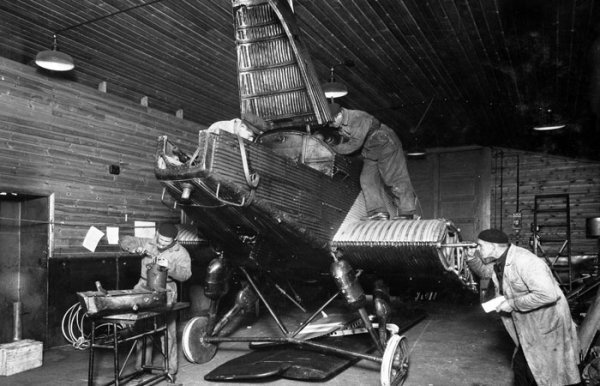
Junker F.13 Maintenance in the early days of Aero Oy
The Union of German airlines formed soon after this with the absorption of the German company Aero Lloyd into Deutsche Luft Hansa. Support for Aero OY from Junkers would decline after this merger as the Junkers factory focused its attention on the larger German carriers. The late 1920s were characterised by events not directly related to scheduled operations. In 1927 the company’s managing director and a group of journalists embarked on Aero’s first round-Finland flight. Lasting more than a month, the flight tour went as far north as Rovaniemi on the Arctic Circle.
Aero’s board of management had previously discussed the company’s domestic traffic plans, and the aim of the tour was to stimulate interest among decision-makers. Aero was already hopeful at this stage of transferring flights to airstrips on land. The towns and cities were however reluctant to build such airstrips. But there was progress on the seaplane side, when the opening of the Turku-Ruissalo air harbour in May 1927 enabled flight traffic to start between Turku and Stockholm.
In 1927, Aero became a member of IATA (The International Air Transport Association); The company was given the code, “AY”, which stands for Aero Yhtiö which means “company” in Finnish. In June 1928, an Aero Junkers F 13 piloted by Gunnar Lihr took part in the search for the explorer Umberto Nobile’s airship, Italia, which had crashed on Spitzbergen. Lihr succeeded in rescuing one of the expedition team, a feat which brought considerable publicity in the world’s press for both Lihr and Aero. Two years later, Aero received more international press coverage when an Aero Oy Junkers F 13 located the Norwegian vessel, Bratvaag, which was carrying the remains of the crew of the ill-fated 1897 Andree Expedition from Spitzbergen.
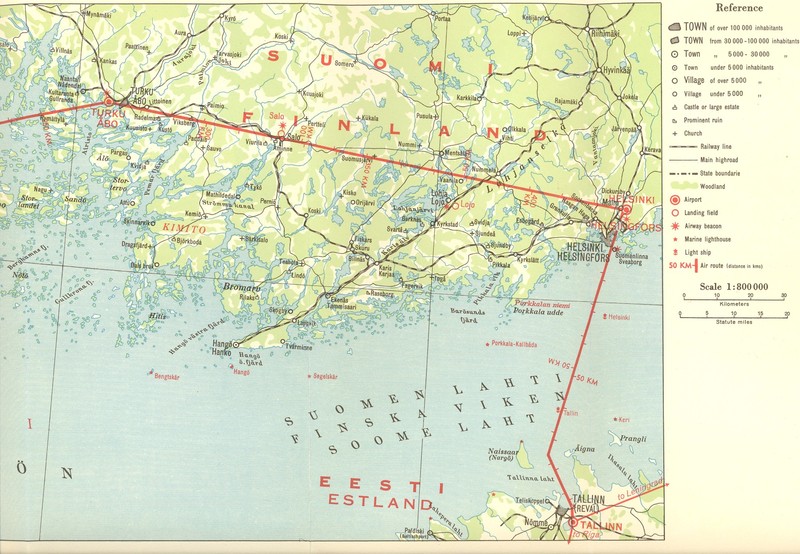
Air Map – Helsinki – Tallinn
Financially, as with all small airlines in the infancy of civil aviation in the 1920’s, Aero Oy struggled with some 534 passengers carried in the first year of operations (1924). Aside from income, the principal obstacle to the development of Finnish civil air traffic was the absence of land-aerodromes. This meant an interruption of traffic in spring and autumn when ice drifts prevent the landing of seaplanes and when, on the other hand, the ice was not thick enough to allow ski-equipped aeroplanes to land. The additional weight of the floats on the early seaplanes also reduced the paying weight that could be carried – meaning sometimes that demands for seats could not be met. However, Aero Oy succeeded in establishing and maintaining a remarkable high percentage of payload and both passenger and mail traffic steadily increased. While 534 passengrs had been carried in 1924, in 1934 the corresponding number was 6,550, in 1935 7,098 and in 1936 8,702. Financially, Aero O/Y first received a subsidy from the Government in 1926 and from that year on continued to receive an annual subsidy. Due to the comparative poverty of Finland through the 1920’s, this was smaller than that given to any other air traffic company in Europe. From 1932 on, Aero Oy began to receive larger subsidies, both direct and indirect.
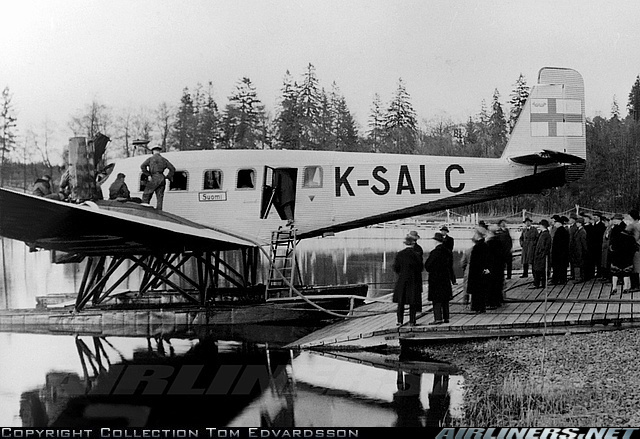
Aero Oy Junkers G24, photo taken at Stockhol (Lindarangen, early 1930’s) – original photo from Finnair
In 1925, Junkers amalgamated its Nord Europa Union and Trans Europa Union air transport subsidiaries into a single company consisting of 16 airlines in nine countries. This new company, Europa Union, was then combined with another German airline interest, Aero Lloyd, to form Deutsche Lufthansa. Aero Oy remained outside this consortium, but received less support from Junkers, which gave priority to the new German air consortium. Aero turned to the Finnish government for financial assistance to acquire new aircraft and with a state-guaranteed loan, in June 1926 the airline took delivery of its first Junkers G 24, a three-engine, nine-passenger seaplane (2 crew + 9 passengers), which was piloted by ex-Ilmavoimat pilot Wäinö Bremer. The G-24 was a three-engined, all-metal, low-wing monoplane design – the single G-24 purchased by Aero Oy was equipped with floats, but not skis, and so could be used in summer only. It remained in service until 1935.
Aero was reluctant to switch to land-based aircraft. In a country with more than 60,000 lakes, the trouble and expense of building runways remained prohibitive as long as Aero continued to operate floatplanes. Additionally, Aero could establish new destinations virtually anywhere there was a lake. While airports were still in the planning stage, Aero Oy was further expanding and as a gradual transition from floatplanes to the planned airports was envisaged, this was taken into account when new aircraft were purchased.
With the August 1929 death of Lucander, the company lost its managing director, who during his brief term of office had made his mark in airline history. Aero appointed Gunnar Stänhle, who was trained as an engineer, as general manager. Lucander’s death also had indirect consequences, because now the Junkers company was Aero’s biggest shareholder. Finnish investors completed a buyout of the German company’s interest and Aero ended its financial relationship with Junkers, becoming an entirely Finnish owned company.
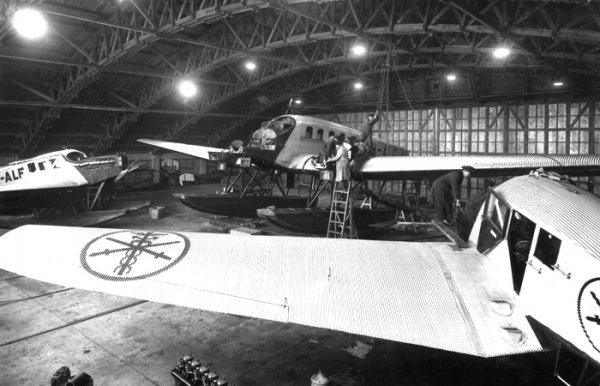
November 1st, 1932: A major overhaul of the Aero Oy Junkers G-24 in progress in a workshop adjacent to Aero Oy’s Kellosaari Hangar. Helsinki got its land airport in 1936 when Malmi Airport was opened and at the same time Aero Oy built a modern hangar for maintenance activities
In 1930 Aero began to establish a closer relationship with other Scandinavian airlines. The company ran night airmail services in cooperation with Swedish, Danish, and later, Dutch airline companies. Junkers, however, remained the company’s major aircraft supplier in the early 1930’s, providing five 14-passenger Ju 52s (the first had been acquired in June 1932 when Aero Oy acquired the first of what would be a small fleet of three-engined Junker Ju 52 airliners, designed for use as either a floatplane or with wheels and capable of carrying 15 passengers plus a crew of 3 (Pilot, Flight Mechanic and Radio Operator). The first Ju 52 fully met expectations and another 4 joined the Aero Oy fleet within a short timeframe).
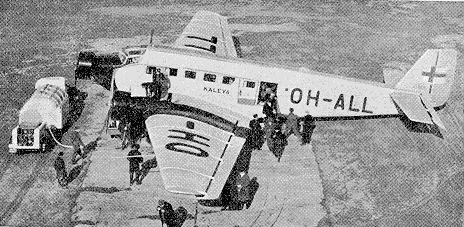
The Helsinki-Stockholm air-liner arrives at the Helsinki aerodrome
Airport construction within Finland proceeded through the mid-1930s, with the government making the necessary funds available as the country’s finances improved. There was a growing awareness of the necessity for having a good airport infrastructure, with all the airfields being dual-use civilian and military. On the 8th September 1935 the dream of the Aero Company’s board of directors would be realised with the opening of Finland’s first civil airport at Turku Artukainen and with the opening of Stockholm’s first civil airport at Bromma on the 23rd of May 1936 pressure grew to establish a landing strip at Helsinki. The location for the Helsinki Airport was decided on as Tattarisuo and the Malmi field was opened to traffic in December 1936 although the airport was not opened officially until May 1938.. With the establishment of these airfields, it was now possible to maintain an uninterrupted connection with other European countries and air traffic consequently grew further. Aero converted its aircraft to wheel landing gear and operated its last seaplane service from Helsinki Katajanokka to Stockholm Lindarängen on December 15, 1936
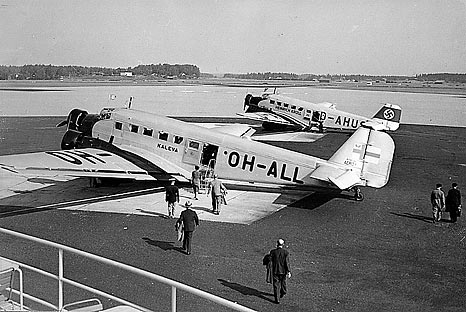
Aero Oy Junkers Ju-52 OH-All “Kaleva” and Lufthansa Junkers Ju-52 (D-AHUS “ Heinrich Kroll”) aircraft at Malmi Airport, Helsinki, late 1930’s
In 1937 Aero took delivery of its first non-Junkers aircraft, two twin-engine DH 89A Dragon Rapides. These planes were operated on domestic routes within Finland. The aircraft, a seven passenger, 2 piston-engined bi-plane was purchased with a special purpose in mind; it would take on Finland’s first scheduled domestic service between Helsinki and Viipuri. From 1 May 1937, Aero began to operate routes between Helsinki-Tampere and and Helsinki-Viipuri using the English twin-engined Dragon Rapide aircraft with a 2 man crew and carrying 7 passengers (the Ju-52’s were reserved for international routes). In 1938 the Viipuri route was extended to Imatra and the Tampere route extended to Vaasa. That summer, airports were rapidly built in Northern Finland and these domestic routes were extended as the “Arctic Air Express” service on the route Helsinki-Tampere-Vaasa-Oulo-Kemi-Petsamo, enabling travelers to fly from Helsinki to the Arctic Coast in one day. During the bathing season a special service was run between Stockholm and Mariehamn on the Åland Islands which proved a great success.
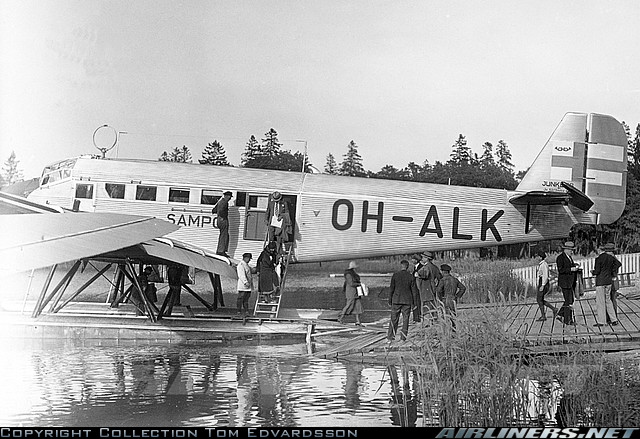
Aero Oy Junkers Ju-52 floatplan “Sampo”. Photo taken at Stockholm, Lindarangen, in the early 1930’s
The late 1930s saw a number of changes to Aero’s international network. In 1937 Aero Oy extended the Stockholm-Helsinki-Tallinn route to Berlin via Riga (Latvia) and Kaunas (Lithuania). Further services were opened to Warsaw and to Copenhagen in 1938. With increased international traffic, an additional five Junkers Ju-52’s were purchased in 1938. There were however many plans for international services set to coincide with the 1940 Olympic games due to be held in Helsinki. To realise these plans, four (OTL – two) Focke-Wulf FW 200B Condor Aircraft were ordered by Aero in 1938. The FW 200 was a German all-metal four-engine monoplane originally developed by Focke-Wulf as a long-range airliner which resulted from a proposal by Kurt Tank of Focke-Wulf to Dr. Rudolf Stuessel of Deutsche Lufthansa to develop a landplane to carry passengers across the Atlantic Ocean to the USA. This fitted in with Aero’s plans to develop a transatlantic service in cooperation with other Nordic airlines. The Second World War unfortunately curtailed Aero’s plans for the time being.
In 1939 war broke out across Europe. The Russians and Germans invaded Poland; Russia invaded Finland on November 30th 1939 and then Estonia in 1940. All available transport aircraft in Finland were then requisitioned by the Suomen Ilmavoimat (Finnish Air Force) and remained under Ilmavoimat control until late 1945.
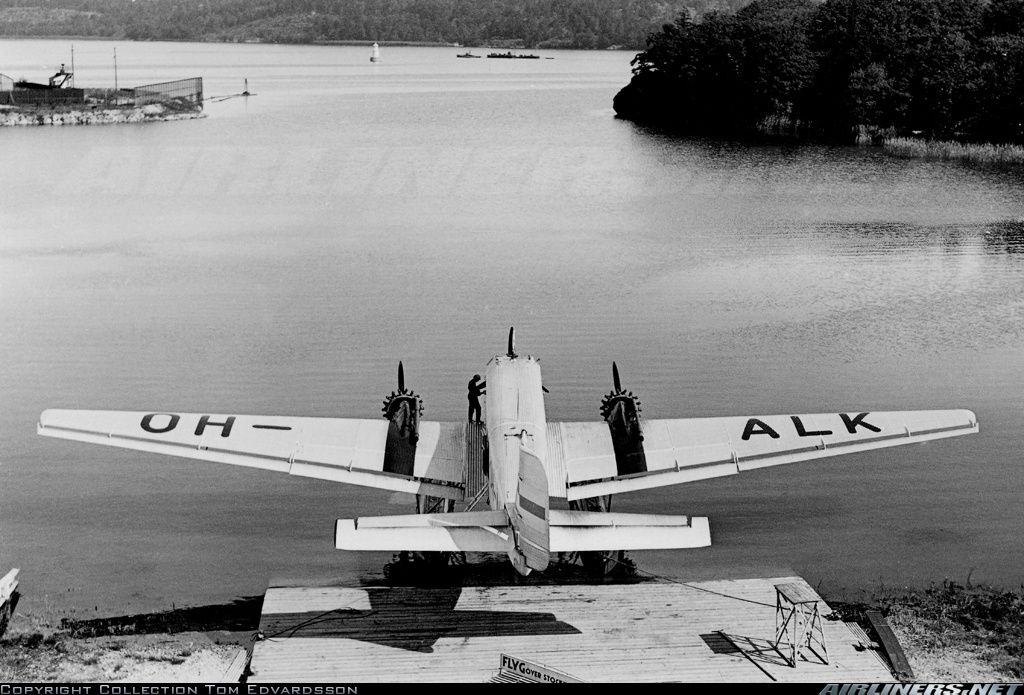
Aero Oy Junkers Ju-52 floatplan “Sampo”. Photo taken at Stockholm, Lindarangen, in the early 1930’s
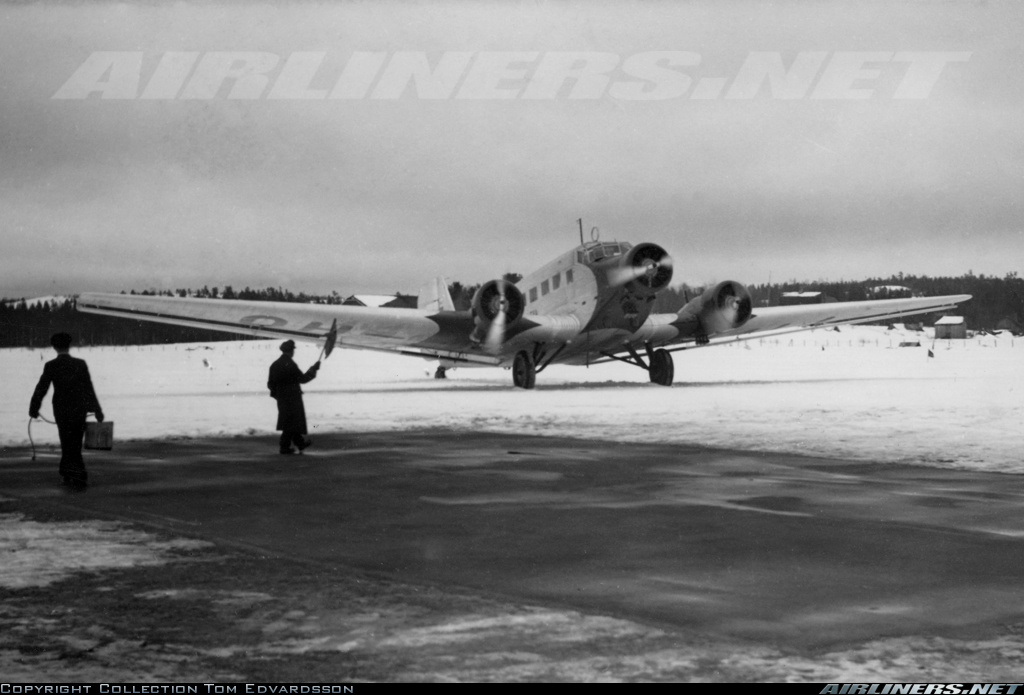
Aero Oy Junkers Ju-52, Malmi Airport, Helsinki, late 1930’s
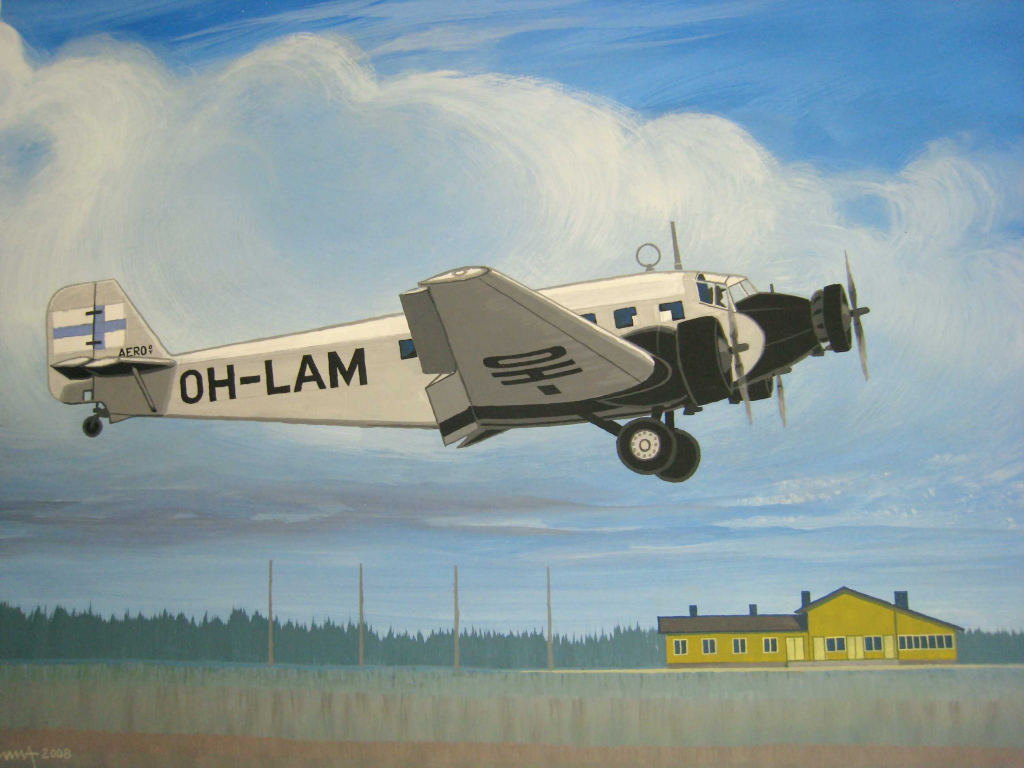
Aero Oy Junkers Ju-52
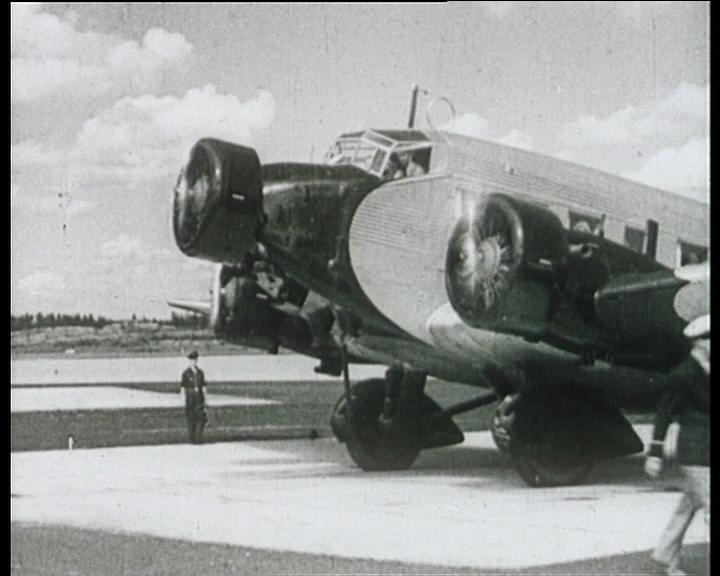
Aero Oy Junkers Ju-52
In anticipation of the 1940 Helsinki Olympics, in early 1938 Aero ordered four German Focke-Wulf Fw 200B (Condor) aircraft, to be delivered in early 1939. The names selected for the four aircraft were Petsamo, Karjala, Myllykoski and Uusimaa. The four Finnish Fw 200`s had been ordered in anticipation of the 1940 Helsinki Olympics and it`s leadup. Capable as they were of trans-Atlantic flights, it was planned that these would be used to fly the Helsinki-London-New York and Helsinki-Paris-Rome routes, as in fact happened. For these long distance flights, the F2 200 was ideal. It had in fact resulted from a proposal by Kurt Tank of Focke-Wulf to Dr. Rudolf Stuessel of Deutsche Lufthansa to develop a land-plane to carry passengers across the Atlantic Ocean to the USA. At that time this was unusual, as airlines used seaplanes on long over-water routes. To fly long distances economically, the Fw 200 was designed to cruise at an altitude of over 3,000 m (9,800 ft) – as high as possible without a pressure cabin. Existing airliners were designed to cruise at altitudes below 5,000 feet. The Fw 200 was briefly the world’s most modern airliner, until other high-altitude airliners started operating: the Boeing 307 in 1940 and the Douglas DC4 in 1942.
The Focke-Wulf Condor was a four-engine low-wing aircraft, fitted with a retractable undercarriage. It had 26 seats and a cruising speed of 325 kph (220mph) with a range of 3,000 kms (1,860 miles). The Condor’s long-range potential made it suitable for international flights – The Condor was the first heavier-than-air craft to fly nonstop between Berlin and New York City, making the journey on 10 August 1938 in 24 hours and 56 minutes. The return trip on 13 August 1938 took 19 hours and 47 minutes. All four Condors were delivered on schedule in early 1939 and Aero Oy inaugarated two new routes – Helsinki-London-New York and Helsinki-Paris-Rome. With the purchase of the aircraft financed by a state guaranteed loan, these routes initially proved commercially viable. Through the Winter War, and indeed for the duration of the Second World War, the long range of the Aero Oy Fw 200`s permitted Finland to maintain scheduled commercial airline flights to Britain and to the USA via Iceland.
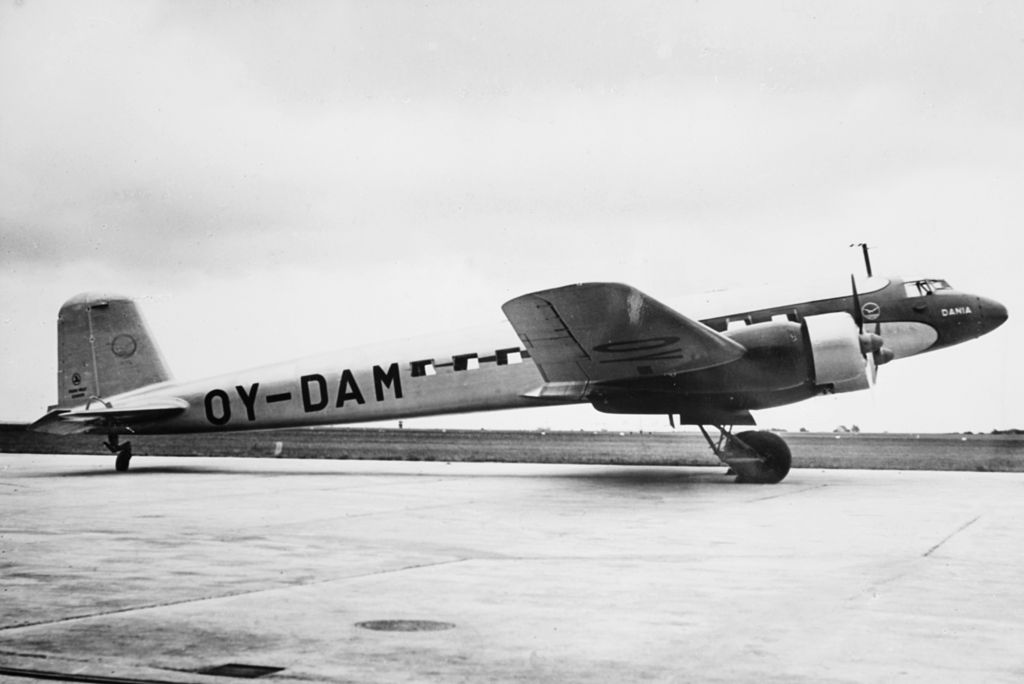
The Danish Airlines’ Focke-Wulf Fw 200 airliner OY-DAM Dania at the opening of the Norwegian airport Fornebu near Oslo, 1 June 1939. “Dania” was flown to Helsinki by its crew following the invasion of Denmark by the Germans and was taken into service by the Ilmavoimat.
Veljekset Karhumäki
The Karhumäki Brothers were sons of a farmer and “the other” pioneers of Finnish civilian aviation. They started flying in Keljo, Jyväskylä in 1924 when Niilo and Valto together with Eemil Kankaanpää and Toivo Huovinen started building the Karhu (“Bear”) 1 aircraft. In the 1920’s the brothers built four aircraft: The Karhus 1, 2, and 3, and Tiira (“Tern”).
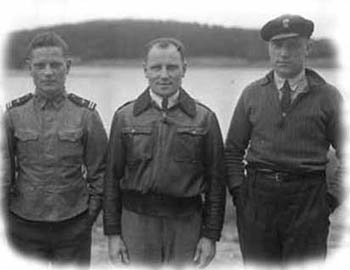
The Brothers Karhumäki
Karhumäki’s business included building, assembling and repairing aircraft in their own factory, training civilian pilots and operating sightseeing and passenger flights. In 1929 the brothers took up aerial photography, which would go on to become an important part of their business. In 1934 a photograph laboratory was built in the new factory building and a photograph technician was hired. In the summer of 1934 the brothers flew 100 hours of aerial photographing flights.
From 1932 on, the Finnish Government made a conscious effort to build up civil aviation within Finland. In parallel with Aero Oy, the Karhumäki Brothers were issued a number of government contracts for regular mail delivery flights and some domestic passenger routes were subsidized. As with Aero Oy, the government provided state-guaranteed loans for the purchase of aircraft and Veljekset Karhumäki took advantage of these to purchase six DH.89 Dragon Rapide aircraft in 1936, which were then utilized to service Government mail contracts. Recognising the potential of aerial mapmaking, in 1935 the Suomen Maavoimat issued a five year contract to the Karhumäki Brothers for aerial photography of frontier areas and subsidized the purchase of advanced cameras for the company on the understanding that these would be used for aerial reconnsaisance in the event of any war. The DH.89’s were also uses for this work.
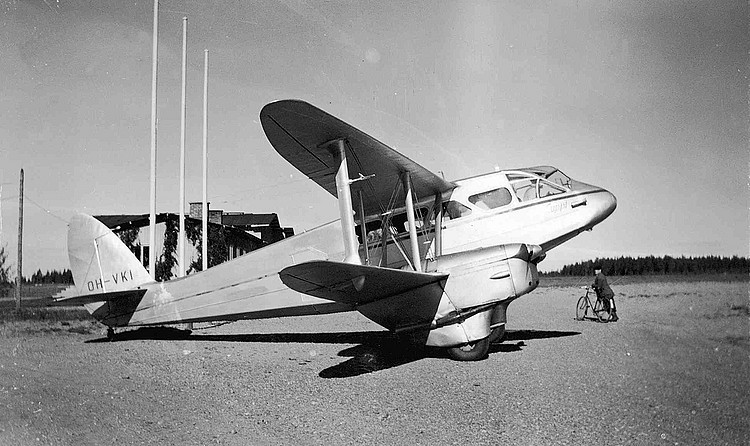
Veljekset Karhumäki de Havillad DH.89 Dragon Rapide Passenger Aircraft
Veljekset Karhumäki were also responsible for the introduction into Finland of the Noorduyn Norseman. Designed and manufactured in Canada for use in similar conditions to those in Finland, the Norseman was a “Bush Plane” designed around a few basic criteria. It should be an aircraft with which an operator utilizing existing talents, equipment and facilities could make money, it should be a high-wing monoplane to facilitate loading and unloading of passengers and cargo at seaplane docks and airports and, finally, it should be an all-around superior aircraft to those currently in use. From the outset, Noorduyn (who had previously worked as an aircraft designer for Fokker) designed the transport to have interchangeable wheel, ski or twin-float landing gear.
Unlike most aircraft designs, the Norseman was first fitted with floats, then skis and, finally, fixed landing gear. The final design layout looked much like Noorduyn’s earlier Fokker designs, it was a high-wing braced monoplane with an all-welded steel tubing fuselage structure and wood stringers applied to it for the attachment of a fabric skin. The Norseman’s wing had an all wood construction and was fabric covered, except for the flaps and ailerons, which were made of welded steel tubing. It had a divided type landing gear fitted to fuselage stubs, the legs were secured with two bolts each to allow the alternate arrangement of floats or skis. The tail wheel strut could be fitted with a wheel or tail skid.
The first Norseman was sold in Canada in January 1936. Sales there were slow but steady as the aircraft proved itself a rugged and reliable workhorse. With a new government contract to provide services to remote communities, Veljekset Karhumäki were in the market for such an aircraft and after reading the specifications, in July 1937, they took delivery of the first Norsemen in Scandanavia. This was a Mk IV model, powered by a Pratt & Whitney Wasp S3H-1 with seating for up to 10, a range of 810 nautical miles, a maximum speed of 140 mph. Impressed with its performance, Veljekset Karhumäki bought another four of the aircraft in 1938. One was loaned to the Ilmavoimat for flight testing, and so impressed were the Ilmavoimat with the Norseman’s performance that in late 1938 they ordered twenty five. These were shipped and delivered in early 1939, entering service with the Ilmavoimat in mid-1939 (most of the Norseman survived WW2, with three being sold to the Swedish Air Force in 1949).
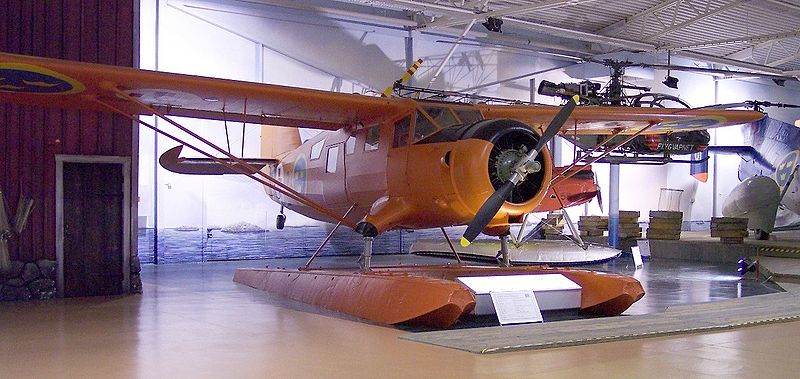
Ex-Ilmavoimat Noordyn Norseman – used throughout the Winter War and for the duration of WW2, three survivors were sold to the Swedish Airforce in 1949 – the last survivor is in the Flygvapenmuseum (The Official Museum of the Swedish Air Force).
Veljekset Karhumäki were the beneficiary of further Ilmavoimat purchases over the period 1937-39. While Aero Oy was buying Junkers Ju-52’s from Germany with state guaranteed loans, the Ilmavoimat was looking for alternative options to support the newly formed Para Jaeger unit – which was at first Battalion strength, then Regimental, then in early 1939 expanded to a full Division with three Regimental Battle Groups. Transport aircraft were needed to support these units, and the Ilmavoimat’s preference was for the Douglas DC3, which they regarded after an earlier purchase of a small number of DC-2’s and trials of the DC3 as superior to the Junkers Ju-52.
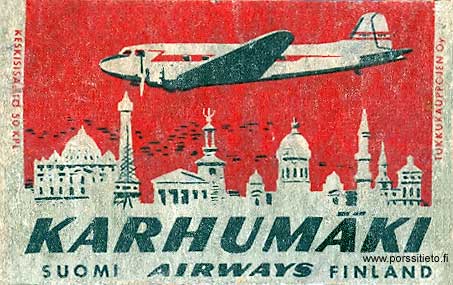
Veljekset Karhumäki DC3
In early 1937, the Suomen Ilmavoimat purchased 20 Douglas DC3 passenger aircraft and “leased” some of these to Veljekset Karhumäki and some to Aero Oy for use as passenger aircraft while also retaining a small number for use by the Ilmavoimat. The DC3’s were listed as part of the Ilmavoimat Reserve, with the civilian Karhumäki Airways crew listed as Ilmavoimat Reservists. The Suomen Ilmavoimat then chartered the DC3’s back from Karhumäki Airways when needed to use as Paratroop training aircraft.
Both the Junkers Ju52 and the Douglas DC-3 were evaluated and a decision was made to purchase the DC3 – with a major influencing factor being the substantial loan made available by the US Government in early 1937 which financed the purchase of the aircraft. Twenty Douglas DC3’s were ordered in the first quarter of 1937. They were built at the Douglas manufacturing plant at Santa Monica, California, Long Beach, California and shipped to Finland, arriving in Turku in late 1937, where they were freighted to the State Aircraft Factory for assembly and test flights, entering service with Aero Oy and Veljekset Karhumäki in the first quarter of 1938, forming a Squadron of the Air Force Reserve. The DC3’s were utlised as passenger aircraft. In war, they were to be mobilised by the Ilmavoimat and would be allocated to a Reserve Squadron whose personnel were all FinnAir aircrew and groundcrew.
In late 1939 with war looming, the Ilmavoimat would go on to purchase further DC3’s using a part of the thirty million US Dollar loan made available by the US Government.
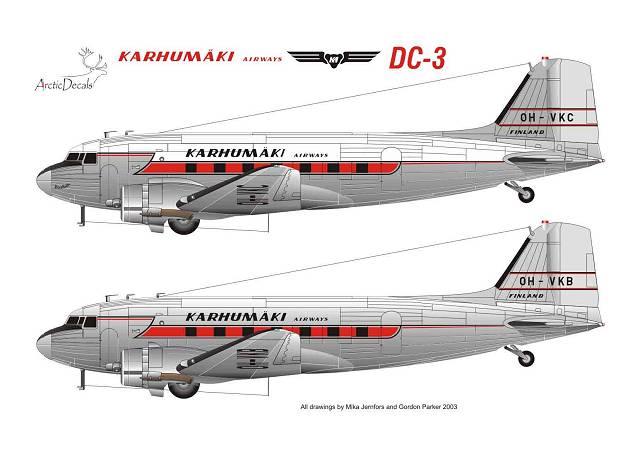
Veljekset Karhumäki DC3 Profile and Colour Scheme
Next: The Early Years of Finlands Air Travel and the construction of Civil Airports
Return to Table of Contents
Previous Page:
Next Page:
 Copyright secured by Digiprove © 2015 Alternative Finland
Copyright secured by Digiprove © 2015 Alternative Finland


